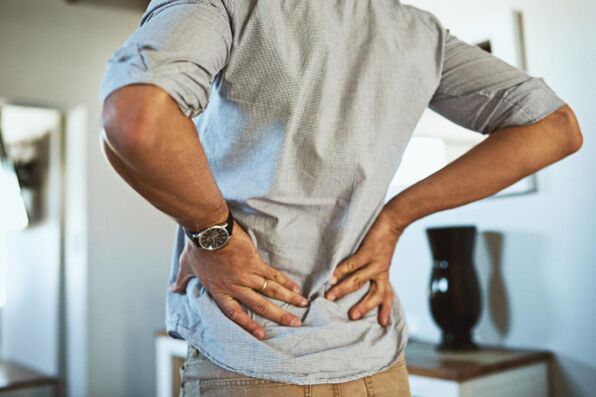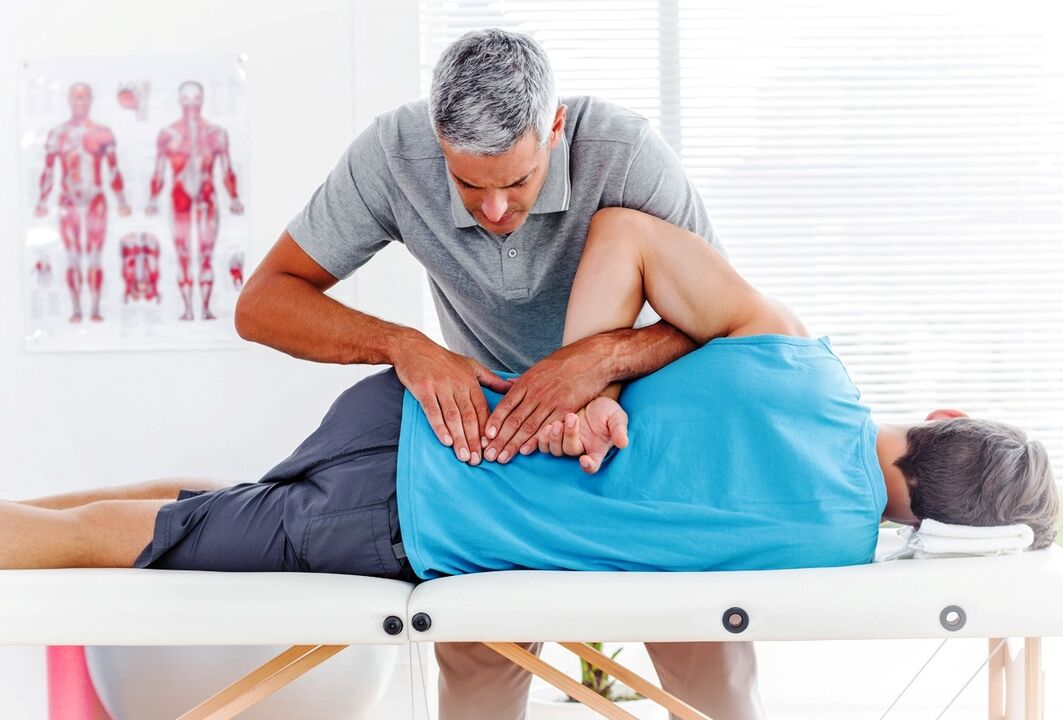
Low painIndicates disease or damage to the spine, neural structure, soft tissue, internal organs, observed in fever states of various origins.It is keen, stupid, constant, periodic, burning, firing.Sometimes it is related to physical exercise, weather changes.Pathology is manifested by lower back pain and is diagnosed based on complaints, dissolution, examination data and other studies: radiographs, MRI, CT.Before diagnosis, peace is needed, and sometimes ointments are allowed, pain medication is performed.
Why are the lower back injured
Spine Diseases
Common causes of lower back pain are congenital abnormalities and acquired spine diseases.The nature of pain syndrome varies.Pain caused directly by pathological processes (usually periodic, local, pain or pulling) is related to weather, physical exercise, maintaining uncomfortable positions.
Due to muscle spasms, cashews (laterally) occur - severe pain and are limited by movement.With many spinal pathology, lumbar behaviors are observed - soreness, burning or firewood, radiation on the back of the thigh.The sensation of pain is often found in radiation syndrome.Can be detected in the following diseases of the spine:
- Degenerative pathology: Osteochondrosis, herniation of the intervertebral disc, disc hernia, spondylosis, spondylitis.
- Congenital abnormalities: s ossification, lumbar vertebrae.
- Multiple biological conditions:Spine, spine, spine cons.
- Vascular Diseases: Violating spinal circulation.
- Other diseases: Respect the disease.
- Secondary lesions of neural structure: Lumbar radiitis, lumbar plexus, various Genesis bone marrow diseases.

The curvature of the spine
For all types of curvature of the spine, secondary or moderate pain was noted, which was associated with non-visual redistribution of loads, overpressure of the muscles and ligaments in the back.Because of uncomfortable physical position, it feels sore when sleeping in a bed that is too hard or too soft.Symptoms are accompanied by:
- Lordosis;
- Kyphosis;
- scoliosis;
- Kyphoscolosis;
- Flat syndrome.
Osteoporosis
The feeling of pain in the lumbar and thoracic spine has long been the only symptom of osteoporosis.Expressing pain syndrome explicitly, exacerbates after loading, before changing weather conditions.Symptoms were observed in the following categories of osteoporosis:
- Postmenopausal;
- juvenile;
- idiopathic;
- senescence.
Similar pains were found in patients with secondary pathology due to genetic diseases, endocrine diseases, chronic toxicity and taking some medications.Secondary osteoporosis may also occur in the context of malabsorption syndrome, liver disease, KHPN, rheumatoid arthritis.
Strengthening pain and increasing pain duration may be related to the development of pathological fractures.Other signs of trauma are not usually expressed, so the fracture is usually still undiagnosed.
Spine injury
The most common injury is bruising in the spine.In mild cases, the pathology manifests as midback pain, aggravation during exercise, local edema, and sometimes hematoma and bleeding.In severe bruises, neurological disorders are added to the listed symptoms.
The compression fractures in the lumbar spine occur due to violent flexion of the body.It is characterized by severe pain, keeping breathing while injured.Then, an increase in pain was noted when the Legion turned, and soft tissue edema was detected.The palpation of the spinous process is painful.Other possible fractures include damage to the arc, lateral processes, spinous processes.
In addition, lower back pain was found in patients with vertebrae and vertebrae subluxation.The pain is paroxysmal, similar to cashew nuts, and the severity and numbness of the lower limbs are supplemented.
Soft tissue and kidney damage
Soft tissue damage is accompanied by minor or moderate rapid relief of local pain and small edema.Bleeding is possible.There is no blood in the urine.Kidney bruises manifest as pain and insignificant short-term hematuria.In the case of kidney damage, pain syndrome is strong and the pain can radiate to the lower abdomen, groin and genitals.Hematoma can be seen in the lumbar area.In severe cases, severe pain, long-term macroscopicity is observed.The impact situation develops.
Spine and spinal cord infections
Osteomyelitis of the spine can be hematogenous, post-traumatic, contact, and post-operatively.The acute form of the disease manifests itself through a combination of rapid increase in lower back pain, cold, fever, poisoning syndrome and worsening in general.The pain twitched, ruptured, so intense that it prevented any movement, forcing the patient to freeze in the bed.In chronic osteomyelitis, the manifestation is uniform, forming a fistula with a corresponding suppurative separation.
Tuberculosis in the spine gradually develops.First, periodic pain was observed, with enhanced post-loading and increased sensitivity of the skin in affected vertebrae projections.The stiffness of the gait is formed.In the context of severe damage to the bone structure, the nature of the pain changes because it is caused by compression of the nerve roots.The pain becomes burning and radiates to the legs, complementing the abnormality and numbness.
In patients with epidural abscesses of the spinal column, the pain is severe, deep, poured, combined with cold, heat therapy, muscle tone.The process of attaching to the spinous process of the vertebrae is painful.As the pathology progresses, rooster syndrome occurs, and then relieves, diseases of the pelvic organs develop.
Local inflammation process
The suppuration process of surface tissue and close to soil fibers is accompanied by severe lower back pain.Possible causes of pain syndrome are boiling, carb bone and paraencephalopathy.
In the first two cases, the abscess is formed in the skin and looks like a limited, severe pain seal, a dark red or dark red shade of blue with one or more poles in the middle.The pain rapidly increases, becoming convulsive, pulsating, and losing sleep.Note the normal high temperature, insignificant or moderate violation of the general state.
Using paraencephalopathic encephalitis, a significant fever occurred at first.Pain syndrome develops after 2-3 days.The pain is very tense and can be given to the stomach or cartilage, which can be aggravated when walking, exercising, and taking deep breaths.In some forms of paraencephalic encephalitis, the patient is in a mandatory position.The waist muscles are tense.Edema, local congestion, high temperature.The situation is very serious.
infectious disease
Diffusion of pain in the lower back, causing a desire to change the position of the body, is a characteristic of acute infection, accompanied by an increase in temperature and poisoning syndrome.In most cases, they are due to myositis, which is often combined with pain in the muscles of the limbs.Suffering from influenza, tonsillitis, acute respiratory virus infection.Sometimes the pain can be caused by kidney damage.Infectious diseases accompanied by lower back pain include:
- bleeding fever;
- Japanese mosquito encephalitis;
- Ebolaje;
- foot and oral diseases;
- Severe coronavirus infection;
- Bacterial, fungal, viral infections in general.
In many patients, lower back pain is observed through cytokine storms - an inflammatory response that develops in the context of severe infectious diseases.Epidemiological myalgia is accompanied by a huge paroxysmal pain that lasts up to 10 minutes, not only in the lower back, but also in other parts of the back, on the abdominal wall, chest, and limbs.Repeat at 30-60 minutes intervals.Combined with rhinitis, conjunctivitis, severe high temperatures.
Other muscle lesions
Muscle pain in the waist area is determined after intense physical fatigue - a manifestation of strength exercise of the back muscles, long-term stay in the forced position of the nervous lower back for a long time.Myalgia subsides, intensifies during exercise, weakens after warming, neatly warm - disappears in a few days.
In the context of exogenous poisoning and metabolic diseases, creatine not only suffers from infectious diseases, but also develops after hypothermia or overload.Accompanied by long-term pain.There are also special forms of myositis:
- specific infectious myositis of syphilis and tuberculosis;
- idiopathic, dermatomyositis and multiple diseases in adolescents;
- Polysitis and dermatomyositis can be used in tumor pathology, systemic diseases of connective tissue.
Fibromyalgia was observed throughout the body, including the lower back.They are combined with sleep disorders, asymptomatic, and neurotic diseases.
Other diseases
In addition to the pathology listed in the lower back, they can also disturb under the following conditions:
- Spine tumors:Sarcoma, hemangioma, metastasis, intramedullary and external tumors of the spinal cord.
- Kidney disease: Pyelonephritis, glomerulonephritis, urolithiasis, kidney heart attack, renal venous thrombosis, renal cysts, renal cancer, suppurative processes.
- Genetic diseases: Hereditary cerebellar ataxia Pierre-Marie.
- Exogenous toxicity: Abuse of phenylapropanol.
- Pathology of the heart and blood vessels: Leffler endocarditis, an aneurysm of the abdominal aorta.
- Emergency: Blood perfusion shock.
For pelvic diseases, exposure to lower back pain is sometimes noticed.There are many female diseases, prostate cancer, projection, and sigmoid colon.
diagnosis
The primary diagnosis was conducted by orthopedic trauma scientists.Neurologists examined it when the patient had neurological symptoms.The doctor interviews the patient and conducts an objective examination.According to the testimony, surgeons, rheumatologists, urologists and other experts were appointed for consultation.Diagnostic procedures may include:
- Neurological examination.During the study, experts evaluate reflexes, muscle strength, coordination of movement, deep and surface sensitivity.
- X-Thunder.On X-rays in the waist department, fractures, reduced disc height, other degenerative changes, volumetric formations, signs of inflammatory processes and signs of spinal slippage.If necessary, functional studies can be supplemented with standard X-rays.
- Other neuroimaging methods.To clarify the data of X-ray photography, CT and MRI were used.During computed tomography, the structure of the solid structure was studied in detail, and the status of the ligaments and intervertebral discs were examined on MRI.To eliminate stenosis, bone marrow studies were performed.
- Functional Research.The status of muscle and nerve conductivity was assessed using electromyography, electrogram and potential-induced studies.
- Laboratory testing.To confirm the infectiousness of the disease, the determination of the pathogen is blood tests and microbiological tests.To detect neurological infections, a serological response was used.

According to the testimony, ultrasonography of the kidney, prostate, pelvic organs, urine tests, abdominal aorta, other studies and other studies were performed.
Linear pain treatment
Help in pre-hospital stage
Due to traumatic damage to the spine, it is necessary to place the patient on the shield and transport it to the medical facility immediately.In the case of non-human pain, it is necessary to reduce the load on the back and optimize the position and rest of the body during work.Acute pain syndrome is a sign of consulting a neurologist.
A single pain medication can be taken before an expert examination.In cashews, lumbar spine disease causes lumbar spine - Irchia, allow the use of locally behavioural warming and painkillers.If an infection process is suspected, local funds will not be displayed.
Conservative Therapy
The basis of treatment is physical therapy measures and drug treatment.Patients are given a protective system.Apply the following method:
- NSAID.Effective in acute and chronic muscles and spine.Used in the form of tablets, local products.
- Neurovitamin.B vitamins are introduced into patients, thereby enhancing the effects of other groups of drugs and helping to relieve pain.
- Local anesthetics.With stubborn and acute pains, therapeutic blockades with anesthetics are performed. To improve the result of treatment, paintillers are combined with glucocorticosteroids.
- Physoalization.Ultrasound, magnetic therapy, percutaneous electrical stimulation, laser therapy, and drug electrophoresis.You can prescribe massage, manual treatment, and acupuncture.
Surgical treatment
Given the pathological characteristics, the following surgical interventions were performed:
- Instability: Internuclear spinal dose, trans fixation, plate fixation.
- Tumors, osteoporosis, osteomyelitis, tuberculosis: legacy surgery, vertebrae, meningoplasty, business.
- Intervertebral hernias: discoctomy, microdisctomy, nuclearoplasty.
- Putting the spinal canal: laminectomy, facetectomy, disk punctuation decompression.
After the operation, prescribe analgesics, antibiotics.Rehabilitation measures include exercise therapy, massage, and physical therapy.



















